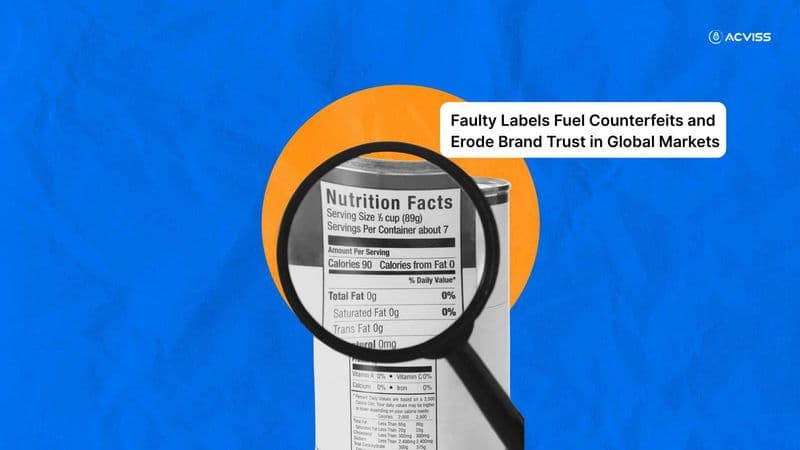Why Faulty Product Labelling Weakens Brand Protection and Fuels Counterfeiting Worldwide

Poor labelling rarely shows up on risk registers. At most companies, it remains a quiet operational nuisance, an irritation for the quality team or the printing vendor. Yet across industries from FMCG to pharmaceuticals to automotive parts, something far more dangerous has been happening. Inaccurate labels, misprints and inconsistent variable data have become silent entry points for counterfeiters.
Counterfeiters exploit gaps. Labels are often the first and easiest gap to exploit. If a product’s identity can be copied, altered or faked, then your entire supply chain becomes vulnerable. Understanding why this happens, where the vulnerabilities lie and how modern anti-counterfeiting solutions address the issue is essential for brand protection and long-term customer satisfaction.
This article explores the chain reaction that poor labelling practices can trigger, why the stakes are rising and what robust, non-cloneable technology can offer as offline protection and product verification tools.
The Invisible Cracks in Labelling That Counterfeiters Love
Most brands assume counterfeiting begins outside the factory. Research from the OECD and EUIPO shows that 80 per cent of counterfeits enter the market through distribution or retail channels, not manufacturing labs. Counterfeiters rarely need to recreate a product. They mainly recreate what makes it look legitimate, and the easiest component to duplicate is the product label.
A label is supposed to validate origin, assure safety and guide customers. When done poorly, it does the opposite. Poor labelling practices directly affect:
- Product authentication
- Brand verification and IP protection
- Regulatory compliance
- Customer engagement and satisfaction
Once that label becomes unreliable, the entire supply chain weakens.
Where Labelling Goes Wrong: The Three Major Points of Failure
1. Basic Printing Errors
Printing errors are more than aesthetic flaws. They are security vulnerabilities. Common issues include smudging, incorrect colour tones, inconsistent print quality, missing details or misaligned designs. These errors happen due to outdated machines, poor quality control and insufficient vendor oversight. When counterfeiters encounter such inconsistencies, they immediately gain two advantages:
- They can mimic the faulty design, making fake items look legitimate.
- They exploit the fact that even original products vary, making verification harder for customers and inspectors.
Printing errors give counterfeiters plausible deniability. If the original labels are inconsistent, then the fake labels no longer stand out.
2. Variable Data Printing Accuracy Failures
Variable Data Printing (VDP) has become essential for product safety and brand protection. Serial numbers, QR codes, batch codes and expiry dates form the backbone of traceability systems.
But VDP is only as strong as its precision. And this is where brands often struggle.
Common VDP failures include:
- Duplicate serial numbers
- Missing serials
- Unscannable or broken QR codes
- Codes printed in the wrong format
- Data mismatches between digital records and printed information
A GS1 study noted that nearly 23 per cent of scanned products show inconsistencies in QR or barcode readability, mainly due to printing defects or data mismatches.
Once these inconsistencies surface, counterfeiters can generate duplicate QR codes or copy entire serial patterns. Fake packaging with accurate but duplicated codes enters the supply chain undetected. This undermines product authentication and allows fakes to blend in seamlessly.
VDP accuracy is not merely a technical issue. It is central to anti-counterfeiting solutions, especially in industries where safety is non-negotiable, such as pharmaceuticals and agrochemicals.
3. Lack of Security Features in Labels
In many emerging markets, labels are treated as branding assets, not security assets. Counterfeiters count on this oversight. A label that uses only basic printing is easy to copy. Add common QR codes without encryption, and the replication becomes effortless.
A report from the International Anti-Counterfeiting Coalition states that basic labels take less than two hours to replicate using easily available printing tools. Source: IACC (https://www.iacc.org)
Without specialised features such as:
- Non-clonable labels
- Covert identifiers
- Digital signatures
- Tamper-evident seals
- Advanced product verification technology
The product remains exposed. Counterfeits enter the market simply because nothing stops them.
The Domino Effect: How Poor Labelling Leads to Real World Damage

1. Loss of Brand Trust
Customers cannot differentiate between real and fake. When something goes wrong, the brand absorbs the blame. Brand protection today is less about policing and more about maintaining customer trust.
2. Product Safety Risks
In categories such as skincare, pesticides, supplements and medicines, the consequences are severe. Faulty labels allow fakes that contain harmful ingredients to pass as genuine. This affects product safety at scale and exposes brands to legal liabilities.
3. Trademark and IP Protection Challenges
Without consistent labelling practices, brands struggle to legally establish ownership and originality. Trademark protection and IP protection become harder when counterfeiters exploit gaps in identity and traceability.
4. Operational Losses
Supply chain teams face difficulty in identifying diversion, unauthorised distribution and fraudulent returns because original and fake labels look identical. This impacts inventory control, sales forecasting and overall financial health.
Why Counterfeiters Target Labels First
Counterfeiters are rational actors. They target the weakest link. Labels are:
- Easy to produce
- Hard to regulate
- Cheap to counterfeit
- Poorly monitored across supply chains
They simply need to copy label design variables such as colour, font, serial pattern or data placement. If a serialised label has no cryptographic protection, counterfeiters reproduce it using simple software.
This is why modern anti-counterfeiting solutions do not treat labels as decoration. They treat them as intelligent identifiers.
What Robust Brand Protection Looks Like Today

Brands need multi-layer defences that combine print-level security, digital authentication and consumer engagement. The most effective solutions today are built around the concept of secure identity. A secure identity ensures three things:
- The product cannot be cloned.
- The product can be verified on demand, even offline.
- The data captured from verification supports supply chain visibility and customer engagement.
Key Components of Modern Brand Protection Solutions
- Non-Cloneable Labelling Technology
Non-cloneable labels use microstructures, secure patterns or cryptographic elements that cannot be reproduced even with advanced printing tools. They offer robust protection against duplication and serve as an anchor for all product authentication efforts. - Secure Variable Data Printing
VDP is no longer about printing serials. It is about an accurate, traceable and unbreakable digital identity. This includes encrypted codes, secure batch linking and backend systems that detect anomalies in real time. - Digital Product Verification
Customers, retailers and inspectors should be able to verify authenticity instantly. QR-based verification, offline protection features and mobile-ready scanning tools help achieve this. - Supply Chain Monitoring and Brand Engagement
Verification data gives brands insight into when, where and how products are authenticated. This enhances customer engagement, helps uncover counterfeit hotspots and improves customer satisfaction.
Where Acviss Fits In: Certify and Non-Cloneable Security
While the primary focus of this article is on the risks and mechanics of poor labelling, it is important to highlight one relevant solution tailored to these issues.
Certify by Acviss integrates non-cloneable labelling technology with secure digital authentication. It ensures:
- Labels cannot be duplicated
- QR codes cannot be forged
- Verification works even in remote markets with offline protection
- Brands gain real-time visibility into counterfeit attempts
It aligns directly with the needs of brands struggling with label accuracy, VDP inconsistencies, and counterfeit risks. Certify strengthens both product verification and brand authentication while enabling better customer engagement and long-term brand protection.
Strengthening Your Labels Strengthens Your Brand
Counterfeiting is not a manufacturing problem. It is a systems problem. And labels are a critical part of that system. As counterfeits grow more sophisticated, basic labels and weak VDP practices simply cannot keep up.
Brands that survive this decade will be the ones that treat labelling not as a cost but as a strategic investment in customer safety, brand trust and product integrity. Combining accurate VDP, secure print practices, and non-clonable technology creates a wall counterfeiters cannot climb.
If your label can be trusted, your brand can be trusted.
Interested to learn more about securing your products and protecting your brand? Get in touch with us.
